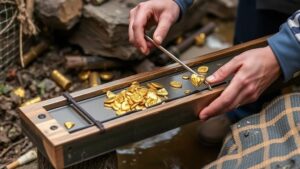Techniques for Dry Panning Fine Gold in Dusty Riverbeds
Techniques for Dry Panning Fine Gold in Dusty Riverbeds
Dry panning is a technique often utilized by prospectors in arid and dusty regions, where traditional wet panning methods are impractical. This article explores effective techniques for dry panning fine gold in dusty riverbeds, delving into the methodology, necessary equipment, and tips for maximizing recovery rates.
Understanding Dry Panning
Dry panning, unlike its wet counterpart, relies on gravity and manual dexterity to separate gold from lighter materials. This method proves useful in environments where water is scarce or where riverbeds are both dry and dusty. Gold, as a heavy metal, sinks quickly and can be separated from lighter soil and dust particles using specialized techniques.
Essential Equipment for Dry Panning
Having the right equipment is critical for effective dry panning. The following items are typically recommended:
- Dry Pan: A shallow pan with a wide base and raised edges allows for easy separation of materials.
- Classifier: A classifier screen helps sort materials by size, enhancing the efficiency of the panning process.
- Sniffer Bottle: This tool helps collect fine gold particles from the pan once they have settled.
- Crevicing Tools: In particular designed tools aid in extracting gold from crevices in rocks or the riverbed.
Techniques for Effective Dry Panning
To maximize the effectiveness of dry panning, practitioners must adopt a systematic approach:
- Gather Material: Start by collecting materials from the riverbed. Focus on areas where water once flowed, as they are likely to contain concentrated deposits of gold.
- Classify the Material: Use a classifier to sift through the gathered material. Removing larger rocks and debris allows finer material to be processed more effectively.
- Dry Pan the Material: Place the classified material in the dry pan and gently shake it side to side. The goal is for the heavier gold particles to separate from the lighter soil.
- Use the Tapping Method: After shaking the pan, tap the sides gently to help gold settle to the bottom. This step is crucial as it aids in further separation.
- Examine the Pan: Once the heavier material settles, inspect the pan carefully for gold. You may observe small glimmers of gold dust among the lighter particles.
- Collecting Fine Gold: Use a sniffer bottle to extract the gold particles effectively from the pan.
Case Study: Successful Applications of Dry Panning
In recent years, the use of dry panning techniques has gained popularity among recreational prospectors in the western United States, particularly in areas like Nevada and Arizona. For example, several prospectors reported finding small but significant amounts of fine gold from riverbeds that were previously deemed unworthy. Their success often stemmed from focusing on previously disturbed areas where heavier materials had settled.
Challenges and Solutions
While dry panning can be fruitful, it is not without its challenges:
- Dust Pollution: Dust can inhibit visibility and make it difficult to see fine gold particles. Wearing a dust mask and using a handheld blower can help mitigate this issue.
- Material Overload: Sifting through a large amount of material can be time-consuming. Utilizing a larger classifier and grouping processing efforts can enhance efficiency.
Actionable Takeaways
For those interested in prospecting for fine gold using dry panning techniques, consider the following actionable steps:
- Select appropriate equipment tailored for dry panning.
- Focus on areas in riverbeds that show signs of historical water flow.
- Practice patience and thoroughness. Dry panning requires a keen eye and steady hand.
- Stay informed about local regulations regarding gold prospecting in your area.
To wrap up, dry panning is a valuable skill for extracting fine gold from dusty riverbeds. With the right techniques and tools, anyone can engage in this rewarding hobby while uncovering the rich geological history of their surroundings.


